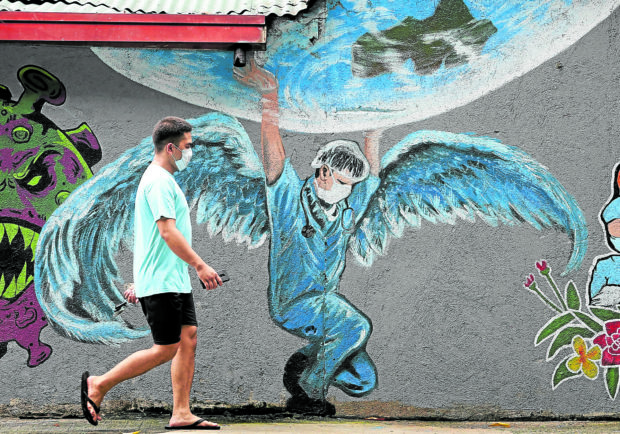
ART THEME A man walks along Osmeña Avenue in Makati City, past a mural depicting a medical health worker carrying the weight of the world. —MARIANNE BERMUDEZ
MANILA, Philippines — The government is considering easing the curfew in Metro Manila but wants businesses to arrange work shifts to avoid rush hours that pose risks of coronavirus transmission.
In a Facebook Live video on Saturday, Cabinet Secretary Karlo Nograles said the Inter-Agency Task Force for the Management of Infectious Diseases and the 17 Metro Manila mayors were discussing the relaxation of the 10-p.m.-5-a.m. curfew in the region to allow longer business hours.
The business community has long been proposing the easing of the curfew to increase economic activities and enable more people to return to work.
Late start of curfew
Nograles, cochair of the task force, defended the curfew, saying it was intended to protect public health during the pandemic.
“The request of the business community and the Metro Manila mayors [is] OK with us. If we want to maintain the curfew, it should not be that early,” Nograles said.
He said it was possible to push the curfew to midnight or to 1 a.m. up to 5 a.m., but businesses must ensure that there would not be “rush hour crowds” of workers going to work or going home that would make it difficult to enforce physical distancing.Nograles suggested “staggered” work shifts to prevent crowding on the roads and on public transport.
Metro Manila is the epicenter of the coronavirus epidemic in the country, accounting for the bulk of daily new infections.New infections
On Sunday, the Department of Health (DOH) reported 2,502 additional infections, bringing the overall number of COVID-19 cases to 339,341.
Of the new infections, 782 were from Metro Manila, 141 from Rizal, 128 from Laguna, 125 from Cavite, and 119 from Bulacan.
The DOH said 83 more patients had died, raising the death toll to 6,321.
It also reported 17,057 recoveries—including mild and asymptomatic patients who had completed 14 days of isolation—pushing the total number of COVID-19 survivors to 293,075.
That left the country with 39,945 active cases, of which 83.0 percent were mild, 11.2 percent asymptomatic, 1.8 percent severe, and 3.9 percent critical. —WITH A REPORT FROM TINA G. SANTOS INQ